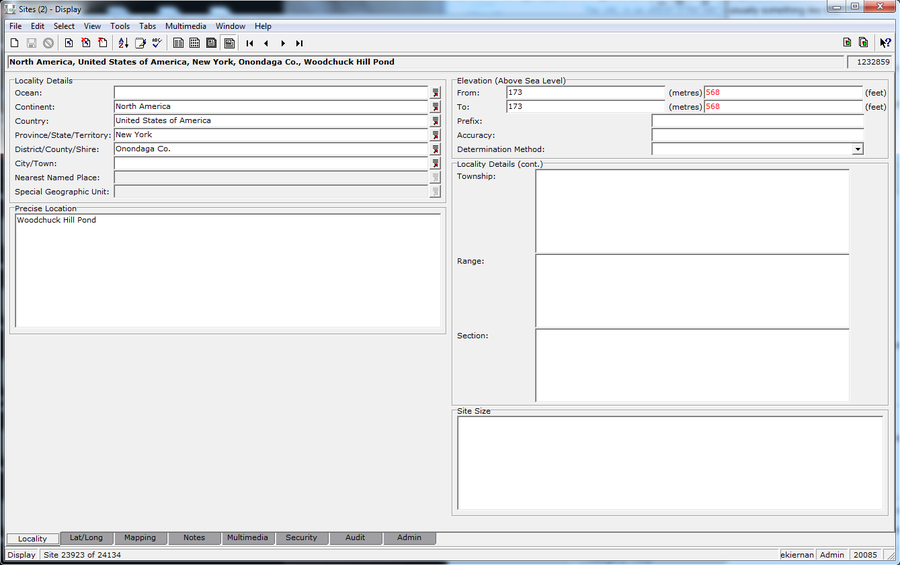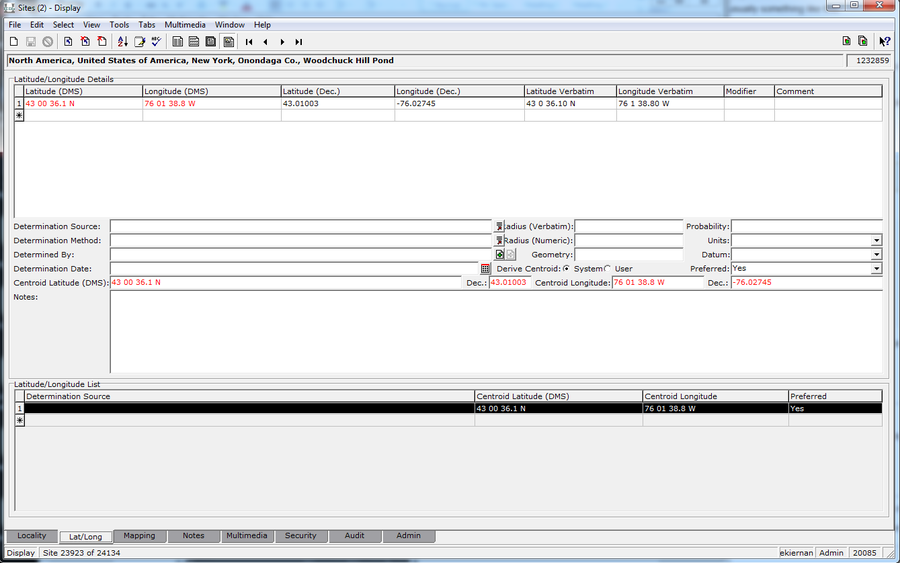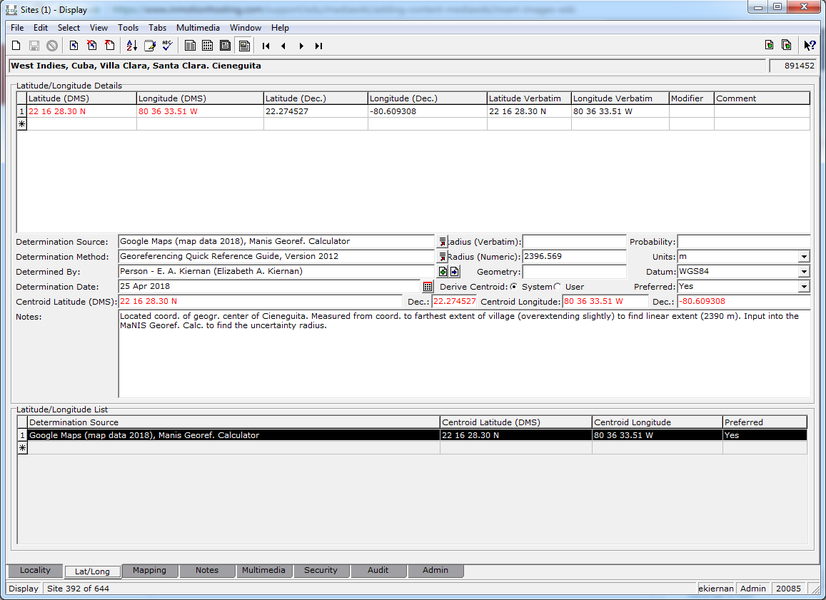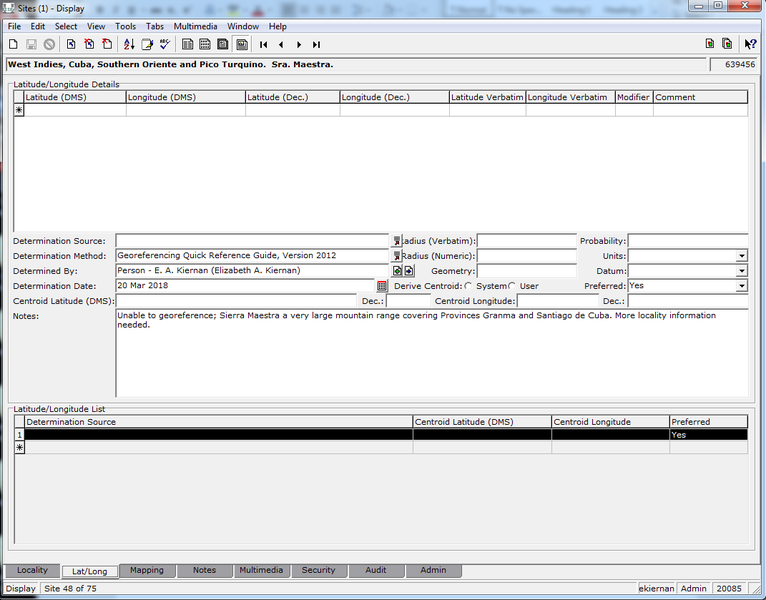Sites Module: Difference between revisions
No edit summary |
No edit summary |
||
| Line 1: | Line 1: | ||
'''<span style="font-size:larger">Locality Tab</span>''' | '''<span style="font-size:larger">Locality Tab</span>''' | ||
Enter all available information from the specimen label into the appropriate field. If you cannot deduce the geographical hierarchy from a label (i.e. if county not provided, handwritten, etc.), place that information into the Precise Location field. Continent, Country, and Province/State/Territory fields are up-to-date and have been locked. This means that the lookup lists for those fields cannot be added to or edited. If you do not see a choice in one of those fields, it likely means the information on the label is outdated or incorrect, but please still include this information in the Precise Location field. Remember to include elevation if provided by the collector, and Township, Range, and Section (TRS) values in the Locality Details section, ensuring "T", "R", and "S" are included in front of the value/direction (i.e. T10S, R23E, S12). | Enter all available information from the specimen label into the appropriate field. If you cannot deduce the geographical hierarchy from a label (i.e. if county not provided, handwritten, etc.), place that information into the Precise Location field. Continent, Country, and Province/State/Territory fields are up-to-date and have been locked. This means that the lookup lists for those fields cannot be added to or edited. If you do not see a choice in one of those fields, it likely means the information on the label is outdated or incorrect, but please still include this information in the Precise Location field. Remember to include elevation if provided by the collector, and Township, Range, and Section (TRS) values in the Locality Details section, ensuring "T", "R", and "S" are included in front of the value/direction (i.e. T10S, R23E, S12). Primary contact for assistance: Liz Gjieli (egjieli@nybg.org). | ||
| Line 55: | Line 55: | ||
<span style="font-size:larger">Coordinates provided on label:</span> | <span style="font-size:larger">Coordinates provided on label:</span> | ||
If coordinates are provided in decimal degrees (-22.00, -42.05) or degrees minutes seconds (22° 00' 29" S, 42° 03' 35" W), input in Latitude/Longitude Details in the designated area. EMu automatically converts between the two formats, so either format is accepted. If coordinates are provided in Township Range Section format (Public Land Survey System), please enter in the “Locality Details (cont.)” section in the Locality Tab, right hand side (as discussed in previous section); this information can be translated into decimal degrees using a coordinate converter calculator at a later time. If UTM coordinates are provided, please note this | If coordinates are provided in decimal degrees (-22.00, -42.05) or degrees minutes seconds (22° 00' 29" S, 42° 03' 35" W), input in Latitude/Longitude Details in the designated area. EMu automatically converts between the two formats, so either format is accepted. If coordinates are provided in Township Range Section format (Public Land Survey System), please enter in the “Locality Details (cont.)” section in the Locality Tab, right hand side (as discussed in previous section); this information can be translated into decimal degrees using a coordinate converter calculator at a later time. If UTM coordinates are provided, please note this information in the Mapping Tab. | ||
| Line 103: | Line 103: | ||
<br/><span style="font-size:larger">Georeferenced information:</span> | <br/><span style="font-size:larger">Georeferenced information:</span> | ||
For the following fields, please do your best to use one of the items listed in the drop-down list for each field rather than writing in a new term. | For the following fields, please do your best to use one of the items listed in the drop-down list for each field rather than writing in a new term. | ||
'''Determination Source:''' ''Source of the coordinates'', or tools used by the georeferencer to locate the collection site. This includes Google Maps, Google Earth, GeoLocate, MaNIS Georeferencing Calculator, paper maps, gazetteer, etc. (“A list (concatenated and separated) of maps, gazetteers, or other resources used to georeference the Location, described specifically enough to allow anyone in the future to use the same resources” – Georeferencing Quick Reference Guide). | '''Determination Source:''' ''Source of the coordinates'', or tools used by the georeferencer to locate the collection site. This includes Google Maps, Google Earth, GeoLocate, MaNIS Georeferencing Calculator, paper maps, gazetteer, etc. (“A list (concatenated and separated) of maps, gazetteers, or other resources used to georeference the Location, described specifically enough to allow anyone in the future to use the same resources” – Georeferencing Quick Reference Guide). | ||
'''Determination Method: '''''Protocols to determine coordinates''.List the georeferencing protocols followed; | '''Determination Method: '''''Protocols to determine coordinates''. List the georeferencing protocols followed, typically a reference guide (Georeferencing Quick Reference Guide, Biogeomancer Guide to Best Practices for Georeferencing) or an online coordinate conversion tool if coordinates were provided on the label in a format other than decimal degrees or degrees minutes seconds. “Other collections” can also be used, which signifies that another collector had collected from the same (or very similar) locality and provided coordinates for that collection. “GPS” can also be noted here. | ||
'''Determined By:''' georeferencer's name (Parties record) | '''Determined By:''' georeferencer's name (Parties record) | ||
'''Determination Date:''' date (short-cut | '''Determination Date:''' date (short-cut for today's date, '''CTRL''' + ''';''' ) | ||
'''Radius (Numeric):''' Uncertainty radius, in meters only. | '''Radius (Numeric):''' Uncertainty radius, in meters only. | ||
| Line 119: | Line 119: | ||
'''Datum:''' WGS84 (datum used by Google Maps, Google Earth, GeoLocate, Bing Maps, OpenStreetMap, etc.) | '''Datum:''' WGS84 (datum used by Google Maps, Google Earth, GeoLocate, Bing Maps, OpenStreetMap, etc.) | ||
'''Notes:''' Please enter concise notes on the methods and steps taken to locate coordinates and radial for the locality. There is a georeferencing notes template document which provides a sample of georeferencing notes to be used per each locality type. Please contact Liz if you do not have access to the most updated georeferencing notes template (egjieli@nybg.org). | '''Notes:''' Please enter concise notes on the methods and steps taken to locate coordinates and radial for the locality. There is a georeferencing notes template document which provides a sample of georeferencing notes to be used per each locality type. Please contact Liz Gjieli if you do not have access to the most updated georeferencing notes template (egjieli@nybg.org). | ||
| Line 171: | Line 171: | ||
<br/>If <u>unable to georeference</u> (unable to find locality or cultivated | <br/>If <u>unable to georeference</u> (unable to find locality or specimen is cultivated): Include georeferencer’s name, date, determination method (if applicable), and in the notes field include a short description including why the location is unable to be determined. | ||
[[File:ScreenShot sites1.png|left|900x600px|ScreenShot sites1.png]] | [[File:ScreenShot sites1.png|left|900x600px|ScreenShot sites1.png]] | ||
Revision as of 13:30, 21 April 2021
Locality Tab
Enter all available information from the specimen label into the appropriate field. If you cannot deduce the geographical hierarchy from a label (i.e. if county not provided, handwritten, etc.), place that information into the Precise Location field. Continent, Country, and Province/State/Territory fields are up-to-date and have been locked. This means that the lookup lists for those fields cannot be added to or edited. If you do not see a choice in one of those fields, it likely means the information on the label is outdated or incorrect, but please still include this information in the Precise Location field. Remember to include elevation if provided by the collector, and Township, Range, and Section (TRS) values in the Locality Details section, ensuring "T", "R", and "S" are included in front of the value/direction (i.e. T10S, R23E, S12). Primary contact for assistance: Liz Gjieli (egjieli@nybg.org).

Example of a completed Locality tab of a Sites record.
Lat/Long Tab
Coordinates provided on label:
If coordinates are provided in decimal degrees (-22.00, -42.05) or degrees minutes seconds (22° 00' 29" S, 42° 03' 35" W), input in Latitude/Longitude Details in the designated area. EMu automatically converts between the two formats, so either format is accepted. If coordinates are provided in Township Range Section format (Public Land Survey System), please enter in the “Locality Details (cont.)” section in the Locality Tab, right hand side (as discussed in previous section); this information can be translated into decimal degrees using a coordinate converter calculator at a later time. If UTM coordinates are provided, please note this information in the Mapping Tab.

Example of a completed sites record when coordinates are provided on a specimen label.
Georeferenced information:
For the following fields, please do your best to use one of the items listed in the drop-down list for each field rather than writing in a new term.
Determination Source: Source of the coordinates, or tools used by the georeferencer to locate the collection site. This includes Google Maps, Google Earth, GeoLocate, MaNIS Georeferencing Calculator, paper maps, gazetteer, etc. (“A list (concatenated and separated) of maps, gazetteers, or other resources used to georeference the Location, described specifically enough to allow anyone in the future to use the same resources” – Georeferencing Quick Reference Guide).
Determination Method: Protocols to determine coordinates. List the georeferencing protocols followed, typically a reference guide (Georeferencing Quick Reference Guide, Biogeomancer Guide to Best Practices for Georeferencing) or an online coordinate conversion tool if coordinates were provided on the label in a format other than decimal degrees or degrees minutes seconds. “Other collections” can also be used, which signifies that another collector had collected from the same (or very similar) locality and provided coordinates for that collection. “GPS” can also be noted here.
Determined By: georeferencer's name (Parties record)
Determination Date: date (short-cut for today's date, CTRL + ; )
Radius (Numeric): Uncertainty radius, in meters only.
Units: m
Datum: WGS84 (datum used by Google Maps, Google Earth, GeoLocate, Bing Maps, OpenStreetMap, etc.)
Notes: Please enter concise notes on the methods and steps taken to locate coordinates and radial for the locality. There is a georeferencing notes template document which provides a sample of georeferencing notes to be used per each locality type. Please contact Liz Gjieli if you do not have access to the most updated georeferencing notes template (egjieli@nybg.org).

Example of a completed georeferenced sites record.
If unable to georeference (unable to find locality or specimen is cultivated): Include georeferencer’s name, date, determination method (if applicable), and in the notes field include a short description including why the location is unable to be determined.
